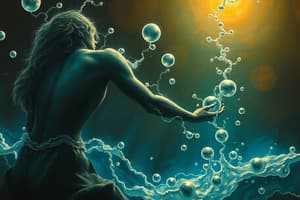Podcast
Questions and Answers
What is the primary role of enzymes in biological reactions?
What is the primary role of enzymes in biological reactions?
- To change the reaction products
- To lower the activation energy (correct)
- To increase the activation energy
- To slow down chemical reactions
Enzyme denaturation is always irreversible.
Enzyme denaturation is always irreversible.
False (B)
What structural feature of enzymes specifically interacts with substrate molecules?
What structural feature of enzymes specifically interacts with substrate molecules?
active site
Enzymes are biological ______ that speed up chemical reactions.
Enzymes are biological ______ that speed up chemical reactions.
How does environmental temperature affect enzyme activity?
How does environmental temperature affect enzyme activity?
Match the following terms with their descriptions:
Match the following terms with their descriptions:
Lowering the pH of an environment always enhances enzyme activity.
Lowering the pH of an environment always enhances enzyme activity.
What must energy input always exceed in living systems to maintain order?
What must energy input always exceed in living systems to maintain order?
What is the primary function of the light-dependent reactions of photosynthesis?
What is the primary function of the light-dependent reactions of photosynthesis?
Photosynthesis first evolved in eukaryotic organisms.
Photosynthesis first evolved in eukaryotic organisms.
What do the products of cellular respiration include?
What do the products of cellular respiration include?
The process that allows glycolysis to continue in the absence of oxygen is called _______.
The process that allows glycolysis to continue in the absence of oxygen is called _______.
Match the following components of cellular processes with their primary functions:
Match the following components of cellular processes with their primary functions:
Which of the following describes the role of the electron transport chain in cellular respiration?
Which of the following describes the role of the electron transport chain in cellular respiration?
Aerobic prokaryotes utilize oxygen as the terminal electron acceptor.
Aerobic prokaryotes utilize oxygen as the terminal electron acceptor.
What is the function of the stroma in chloroplasts?
What is the function of the stroma in chloroplasts?
The reaction pathway that releases energy from glucose is called ______.
The reaction pathway that releases energy from glucose is called ______.
Match the following processes with their occurrences:
Match the following processes with their occurrences:
What components are synthesized during the Calvin Cycle?
What components are synthesized during the Calvin Cycle?
The folding of the inner mitochondrial membrane decreases the surface area for ATP synthesis.
The folding of the inner mitochondrial membrane decreases the surface area for ATP synthesis.
How does oxidative phosphorylation differ from photophosphorylation?
How does oxidative phosphorylation differ from photophosphorylation?
Cellular respiration converts _______ stored in biological macromolecules into usable energy.
Cellular respiration converts _______ stored in biological macromolecules into usable energy.
Which statement best describes the connection between cellular functions and the variation in molecules within cells?
Which statement best describes the connection between cellular functions and the variation in molecules within cells?
Flashcards
Active Site
Active Site
The specific region on an enzyme where substrate molecules bind and interact.
Enzymes as Catalysts
Enzymes as Catalysts
Enzymes act as biological catalysts, speeding up chemical reactions within cells by lowering the activation energy required for the reaction to occur.
Enzyme Denaturation
Enzyme Denaturation
The disruption of an enzyme's protein structure, leading to loss of its catalytic function. Caused by factors like extreme temperature or pH.
Optimal Temperature for Enzymes
Optimal Temperature for Enzymes
Signup and view all the flashcards
Optimal pH for Enzymes
Optimal pH for Enzymes
Signup and view all the flashcards
Competitive Inhibitors
Competitive Inhibitors
Signup and view all the flashcards
Noncompetitive Inhibitors
Noncompetitive Inhibitors
Signup and view all the flashcards
Energy Flow in Living Systems
Energy Flow in Living Systems
Signup and view all the flashcards
Photosynthesis
Photosynthesis
Signup and view all the flashcards
Light-Dependent Reactions
Light-Dependent Reactions
Signup and view all the flashcards
Calvin Cycle
Calvin Cycle
Signup and view all the flashcards
Photosystem
Photosystem
Signup and view all the flashcards
Electron Transport Chain (Photosynthesis)
Electron Transport Chain (Photosynthesis)
Signup and view all the flashcards
Cellular Respiration
Cellular Respiration
Signup and view all the flashcards
Glycolysis
Glycolysis
Signup and view all the flashcards
Krebs Cycle
Krebs Cycle
Signup and view all the flashcards
Electron Transport Chain (Cellular Respiration)
Electron Transport Chain (Cellular Respiration)
Signup and view all the flashcards
Oxidative Phosphorylation
Oxidative Phosphorylation
Signup and view all the flashcards
Fermentation
Fermentation
Signup and view all the flashcards
Stroma
Stroma
Signup and view all the flashcards
Thylakoids
Thylakoids
Signup and view all the flashcards
Cristae
Cristae
Signup and view all the flashcards
Study Notes
Enzyme Structure and Function (3.1 & 3.2)
- Enzymes are biological catalysts that speed up chemical reactions in cells.
- Enzymes have an active site, a specific region for interacting with substrate molecules.
- Substrate shape and charge must match the active site for enzyme activity.
- Enzymes lower activation energy, the energy needed for a reaction to begin.
- Enzyme structure affects their function; changes can alter/disable catalytic capabilities.
Environmental Impacts on Enzyme Function (3.3)
- Denaturation occurs when proteins lose their three-dimensional structure, halting enzyme function.
- Environmental pH and temperature outside optimal ranges can denature enzymes, affecting reaction efficiency.
- Denaturation can sometimes be reversible.
- Enzyme activity is affected by environmental pH, disrupting hydrogen bonds vital to enzyme structure.
- Substrate and product concentration impact reaction efficiency.
- Higher temperatures increase molecule movement, increasing collisions between enzymes and substrates, and reaction rate.
- Competitive inhibitors reversibly or irreversibly bind to the active site, blocking substrate access.
- Noncompetitive inhibitors bind at allosteric sites, altering enzyme activity.
Cellular Energy (3.4)
- Living systems need a constant energy input to maintain order and drive cellular processes.
- Energy input must surpass energy loss to sustain order.
- Energy-releasing and energy-requiring processes can be coupled.
- Metabolic pathways are sequential, controlling and improving energy transfer.
Photosynthesis (3.5)
- Photosynthesis captures solar energy and converts it into stored chemical energy (sugars).
- Photosynthesis originated in prokaryotes.
- Photosynthesis in cyanobacteria led to an oxygenated atmosphere.
- Prokaryotic pathways were foundational to eukaryotic photosynthesis.
- Light-dependent reactions use light energy to generate ATP and NADPH, used by the Calvin Cycle.
- Photosystems contain chlorophyll that absorbs light energy, boosting electrons.
- Light-dependent reactions occur in the thylakoid membranes of chloroplasts.
- Electron transport chains (ETC) transfer energized electrons via a series of reactions, creating a proton electrochemical gradient.
- Electrochemical gradient drives ATP synthesis using ATP synthase.
Cellular Respiration (3.6)
- Cellular respiration and fermentation utilize energy from biological molecules to produce ATP.
- Eukaryotic respiration involves a series of enzyme-catalyzed reactions.
- Electron transport chain reactions occur in chloroplasts, mitochondria, and prokaryotic cell membranes.
- Electrons are passed down an ETC to oxygen, the terminal electron acceptor during aerobic respiration.
- In respiration, NADH and FADH2 deliver electrons to the ETC.
- Proton gradient across membranes drives ATP synthesis via chemiosmosis.
- Oxidative phosphorylation generates ATP in cellular respiration (like photophosphorylation in photosynthesis).
- Decoupling can generate heat to regulate body temperature.
- Glycolysis breaks down glucose to ATP, NADH, and pyruvate.
- Fermentation enables glycolysis in oxygen absence, producing waste (alcohol, lactic acid).
- Pyruvate enters the mitochondria for further oxidation.
- Krebs cycle releases CO2, synthesizes ATP, and transfers electrons to NADH and FADH2.
- ETC transfers electrons from the Krebs cycle and glycolysis.
- Gradient of protons across inner mitochondrial membrane drives ATP synthesis.
Cell Structure and Function (3.6 & 2.2)
- Chloroplasts contain stroma (fluid outside thylakoids) and thylakoids in grana stacks.
- Light-dependent reactions in thylakoid membranes.
- Carbon fixation (Calvin Cycle) in stroma.
- Mitochondria's inner membrane folds (cristae) increase surface area for ATP production.
Fitness (3.7)
- Cell variation in molecules (e.g., phospholipids, hemoglobin, chlorophylls) affects an organism's ability to survive and reproduce in varying environments.
Studying That Suits You
Use AI to generate personalized quizzes and flashcards to suit your learning preferences.




